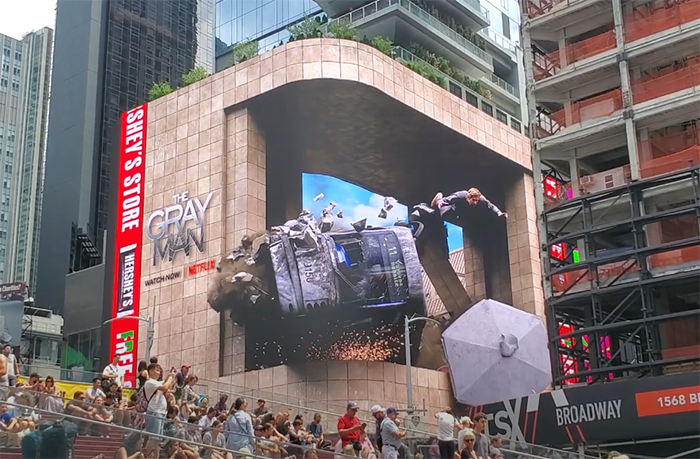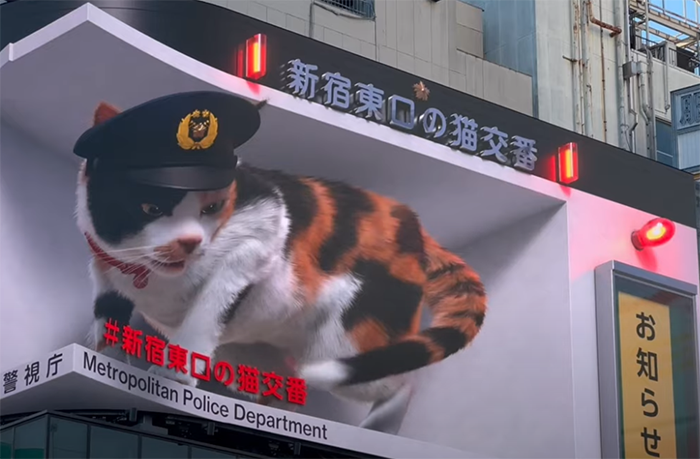In the ever-changing world of advertising, grabbing the audience’s attention is critical. Traditional billboards have long been a fixture of outdoor advertising, but in an age where digital engagement reigns supreme, a new competitor has emerged: the 3D billboard. These inventive displays are altering urban settings, combining technology and creativity to engage viewers in unexpected ways. This article delves into the technology underlying 3D billboards, their benefits, uses, and the future of this innovative advertising medium.By the way,We have shared our naked eye 3D project on Instagram. Welcome to follow our account to check it out!
Table of contents
- What is 3D billboard?
- Where do we usually see 3D billboards?
- Compared with 2D screens, what are the advantages of naked-eye 3D?
- How many companies have successfully promoted their brands using 3D billboards?
- What factors affect the price of 3D billboard?
What is 3D billboard?
Naked-eye 3D LED screens, also known as glasses-free 3D LED displays, are a cutting-edge technology that allows users to see three-dimensional images without the need of special eyewear. The following are some significant technologies and components used in the construction and functionality of these screens:
1. High-Resolution LED Panels:
– Pixel Density: High pixel density is crucial for creating clear and sharp 3D images. Smaller pixel pitches allow for more detailed visuals.
– Brightness and Contrast: High brightness levels and excellent contrast ratios enhance the depth perception and realism of 3D content.
2. Autostereoscopic Technology:
– Parallax Barrier: This method uses a layer with precisely placed slits in front of the display. These slits allow each eye to see a different set of pixels, creating a 3D effect.
– Lenticular Lenses: A layer of lenticular lenses is placed over the display, directing light from different angles to each eye, producing a stereoscopic effect without the need for glasses.
3. Real-Time Rendering and Image Processing:
– 3D Rendering Engines: Advanced software engines render 3D content in real-time, adjusting images for the best viewing experience from different angles.
– Depth Mapping: This involves creating and using depth maps to position objects correctly in a 3D space, ensuring accurate depth perception.
4. Viewing Angle Optimization:
– Multi-View Display Technology: This technology supports multiple views simultaneously, allowing the 3D effect to be visible from various angles.
– Eye Tracking: Some advanced systems incorporate eye-tracking technology to adjust the 3D images based on the viewer’s position, enhancing the effect.
5. Content Creation and Management:
– 3D Content Production: Specialized software and tools are used to create 3D content, ensuring that the visuals are optimized for naked-eye 3D displays.
– Content Management Systems (CMS): These systems manage and distribute 3D content, ensuring it is displayed correctly on the screens.
6. Hardware Integration:
– Synchronization Systems: Ensures that the 3D content is perfectly synchronized across multiple screens for a seamless viewing experience.
– Signal Processing Units: These units handle the complex signal processing required to render and display 3D images accurately.
7. Advanced Materials:
– Optical Films and Coatings: These materials enhance the display’s ability to project 3D images by improving light direction and reducing glare.

Where do we usually see 3D billboards?
1. Urban Centers and City Squares
One of the most iconic locations for advertising, Times Square is known for its high concentration of digital billboards. The introduction of 3D billboards has taken the visual spectacle to new heights, drawing millions of tourists and locals.Similar to Times Square, Piccadilly Circus is a major advertising hub where 3D billboards attract attention from a diverse audience.
2. Shopping Malls and Retail Areas
Orchard Road in Singapore, Fifth Avenue in New York, and the Champs-Élysées in Paris all employ 3D billboards to attract customers and improve the shopping experience. Indoor shopping malls, such as Dubai Mall, Mall of America, and Westfield London, employ 3D led billboard to create captivating visual displays that draw customers to specific businesses or events.
3. Entertainment and Sports Venues
Sports facilities such as New York’s Madison Square Garden, London’s Wembley Stadium, and Los Angeles’ Staples Center employ 3D billboards to engage spectators and promote events, goods, and sponsors. Furthermore, venues that stage concerts, Broadway musicals, and other acts employ 3D billboards to provide immersive pre-show experiences and promote forthcoming events.
4. Public places and tourist attractions.
Famous monuments such as the Eiffel Tower in Paris, the Statue of Liberty in New York, and Australia’s Sydney Opera House all have spaces around them where 3D billboards may be carefully placed to attract and excite tourists.
Compared with 2D screens, what are the advantages of 3D Billboards?
Naked-eye 3D technology, also known as autostereoscopic 3D. These benefits make it a compelling choice for advertisers, entertainment providers.
1. Enhanced Visual Impact
Naked-eye 3D screens create a sense of depth, making images and videos appear more lifelike and immersive. This three-dimensional effect can significantly enhance the visual appeal of the content. This is particularly beneficial in high-traffic areas where capturing the audience’s attention is crucial.
2. Memorability and Recall
Studies have shown that 3D content tends to be more memorable than 2D content. The unique visual experience provided by 3D screens helps in creating lasting impressions on viewers.
3. Viewer Engagement
3D technology can be combined with interactive elements to create a more engaging user experience. This can include features like gesture control or augmented reality (AR) integration.
4. Viewer Comfort and Convenience
Naked-eye 3D screens eliminate the need for special glasses, making the viewing experience more comfortable and accessible to a larger audience while also minimizing difficulties connected with previous 3D technologies such as eye strain and pain.
5. Technological Integration
Naked-eye 3D screens can be integrated with AR and VR technologies to create more immersive and interactive experiences.
Although 3D billboards have the advantages listed above, they are frequently more expensive than traditional 2D LED displays. If you have a large budget and want to exhibit more realistic images using 3D effects, draw more attention, and make a lasting impact on the audience, you may read more about3D led billboard and buy the best 3D billboard for your needs. At the same time, typical 2D LED displays are ideal for advertisers with a small budget who wish to obtain widespread recognition and publicity.
How many successful examples of attention-grabbing 3D billboards exist?
The use of 3D billboards has seen a significant uptick in recent years, with many companies leveraging this innovative technology to create impactful advertising campaigns.
1. Coca-Cola
Coca-Cola has been a pioneer in using 3D billboards. They have implemented eye-catching 3D displays in various locations, including Times Square in New York City. Their campaigns often feature dynamic animations and interactive elements that enhance brand engagement and visibility.


2. Nike
Nike has utilized 3D led billboard to showcase their latest products and campaigns. For example, their 3D billboard in Tokyo’s Shibuya district featured a giant, animated version of their latest sneaker, creating a buzz and drawing attention from passersby.

3. Samsung
Samsung has effectively used 3D led billboard to promote their latest technological innovations, such as new smartphones and televisions. Their campaigns often highlight the high-tech features of their products, aligning well with the cutting-edge nature of 3D display technology.

4. Netflix
Netflix has employed 3D billboards to promote their original series and movies. One notable example is their 3D billboard campaign for the series “Stranger Things,” which featured dramatic and immersive visuals that captivated audiences.

5. McDonald’s
McDonald’s has used 3D billboards in various global markets to promote new menu items and special offers. Their campaigns often incorporate fun and playful elements that resonate with their brand identity.

6. Shibuya 3d billboard
The Shibuya 3D billboard is a cutting-edge digital advertising display located in Shibuya, Tokyo. It features a massive, curved LED screen that uses 3D visual effects to create lifelike, eye-catching advertisements. The screen, positioned above Shibuya Station, creates the illusion of depth without requiring viewers to wear special glasses. One of its most iconic displays features a realistic 3D cat that appears to jump out of the billboard, captivating pedestrians. This technology highlights the growing trend of immersive outdoor advertising, blending innovation and entertainment in high-traffic urban areas.


What factors affect the price of 3D billboard?
The price of a 3D billboard can vary significantly based on several factors. These factors encompass both the initial installation costs and the ongoing expenses associated with maintaining and operating the billboard. Here’s a detailed look at the key factors that influence the price of a 3D billboard:
1. Technology and components.
Display Technology:
Types of LED Panels: High-resolution LED panels with lower pixel pitches are more costly but provide superior picture quality and depth perception.
3D Technology: The mechanism utilized to generate the 3D effect, such as autostereoscopic displays, parallax barriers, or lenticular lenses, can all influence pricing.
Hardware:
Advanced graphics processing units (GPUs) and other gear necessary to create and show 3D information can drive up expenses.
Synchronization Systems: Equipment for synchronizing material across several panels or huge monitors might be expensive.
2. Size and Resolution.
Screen Size:
Larger Displays: Larger 3D billboards are inherently more expensive owing to the additional materials and technology necessary.
Custom Sizes: Because custom-sized billboards or unusual forms need unique engineering and production, they might be more expensive.
Resolution:
Higher Resolution: Higher pixel density improves visual clarity but comes at a higher cost. Ultra-high-definition (UHD) displays cost more than standard-definition panels.
3. Content Creation.
Complexity of 3D Content:
Custom 3D Animations: Creating unique 3D material necessitates specific expertise and tools, which may be expensive.
Depth and Interactivity: Creating more sophisticated and engaging 3D material will take longer and cost more.
Frequency of updates:
Regular Content Changes: Frequently altering the 3D content necessitates continuing development, which might increase the overall cost.
Adding interactive elements, such as real-time data integration or user engagement, can drive up content development costs.
4. Installation and Infrastructure Location
Location:
Urban vs. Rural: Because of greater land values and logistical constraints, installing a 3D billboards in a bustling urban area is usually more expensive.
Accessibility: Difficult-to-access areas may need specialized equipment and more personnel, raising installation costs.
Structured Support:
Mounting Structures: The design and installation of supporting structures such as poles or building attachments raises the cost.
Engineering requirements: To ensure that the 3D billboard can survive environmental conditions such as wind and weather, extra engineering and materials are required.
5. Permits and regulations.
Local Regulations:
Zoning regulations: Complying with local zoning regulations and acquiring essential licenses might increase the cost.
Advertising regulations: Meeting certain advertising standards, such as brightness and content limits, may necessitate more investment.
Environmental Impact:
Light Pollution Controls: Putting in place measures to control light pollution, such as employing adaptive brightness technology, can be costly.
Sustainability Initiatives: Using sustainable materials and techniques, such as recyclable components, may increase the initial cost but provide long-term advantages.

If you have such needs, please feel free to contact us!
Other LED screen cases from our company
 Tecnon Smart Display Technology Shenzhen Co., Ltd.
Tecnon Smart Display Technology Shenzhen Co., Ltd.



